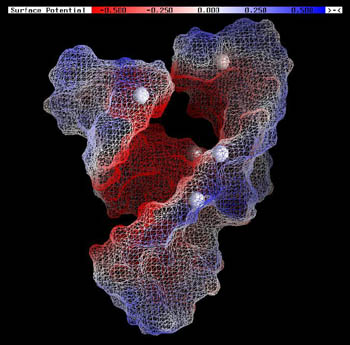

 |
 |
Comp Chem Research Developments | |
| Archive of Comp Chem Research News | |
June 28, 2000
|
|
The York group has recently developed a quantum approach for macromolecular characterization based on "linear-scaling" electronic structure theory. The methods allow quantum calculations on large solvated biomolecules to be performed in order to determine from first principles important biological properties such as electrostatic potential surfaces and reactivity indices (Fig. 1). In an upcoming special issue of the Journal of Computational Chemistry, graduate student Jana Khandogin, postdoctoral associate Anguang Hu and Professor Darrin York report the first applications of these techniques to the determination of the electronic properties of different forms of DNA and RNA in solution. In addition to the widely used classical electrostatic potential surface maps that are based on empirically-derived static point charges, now fully quantum mechanical electrostatic potentials that include electronic polarization are possible. The linear-scaling electronic structure methods being developed in the York group provide a means to compute a host of quantum mechanical properties that may greatly extend the range of prediction for problems of macromolecular characterization. |
|
 Fig. 1: Electrostatic potential surface of the hammerhead ribozyme in solution.
|
|
|
| |